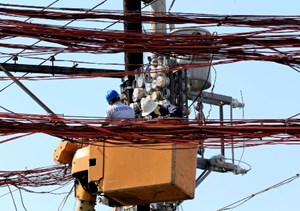As gas reserves wane, Philippines faces rising costs in switch to LNG
(Reuters) - With just four years before the Philippines' only gas field is set to run dry, the country has started importing liquefied natural gas (LNG), creating a fresh headache for a government struggling to curb high inflation.

LNG is needed to help replace gas from the Malampaya field, which supplies power plants that meet a fifth of the electricity requirements on the country's main Luzon island, or 13% of total installed capacity nationwide.
Imported gas costs will be passed straight through to power prices, and as a result power prices could jump sharply, a challenge for a country where inflation hit a worrying 14-year high in January.
While LNG prices have dropped from record highs hit last year amid Europe's scramble for gas, they are expected to rise again as demand climbs for winter, and as Hong Kong, Vietnam and the Philippines all become first-time LNG buyers this year.
"A big challenge is LNG price volatility and how secure is supply," said Irwin Yeo, senior LNG analyst at Poten & Partners.
The country "will face economic and political risks" from the passing through of LNG costs to power prices, he said.
Gas output at the Malampaya field has declined sharply since peaking in 2019, hitting its lowest since 2004 last year, data from the energy department showed.
Initially the country will need around 3 million tons per year (tpy) of LNG to replace Malampaya's supply but that will fall to around 2.3 million-2.7 million tpy and possibly less by 2030, depending on how rapidly generation from renewable energy grows, said Kittithat Promthaveepong from consultancy The Lantau Group.
The Philippines aims to have 35% of its power generated by renewables by 2030, up from about 23% currently.
LNG price risk
The country's debut LNG cargo with 137,000 billion cubic meters of gas arrived in April for trials at its first import terminal, to supply San Miguel Global Power Holdings.
Next, First Gen (FGEN.PS), which uses Malampaya gas at four power plants with a combined capacity of 2,000 megawatts, plans to start LNG imports in September when its floating storage and regasification unit (FSRU) in Batangas province is ready.
First Gen President Francis Giles Puno said without LNG the company would face even higher fuel costs as it would have to rely on expensive diesel.
"So the LNG is there to temper the cost of fuel," he told reporters on May 17.
Securing long-term LNG contracts will be challenging for the new market entrant despite current low prices, as supplies globally remain tight at a time when other emerging markets like Vietnam and Bangladesh are also competing for gas, analysts say.
Fortuitously for new buyers, spot LNG prices have fallen to $9.80 per million British thermal units (mmBtu) in May following a mild winter and lower demand, after averaging nearly $40/mmBtu in 2022, propelled by the Russia-Ukraine war.
"But the consensus is that this dip in prices isn't expected to last," said Sam Reynolds, an analyst at the Institute for Energy Economics and Financial Analysis (IEEFA).
LNG is currently about $1-$3/mmBtu costlier than Philippine gas, based on a $70 a barrel oil price, two analysts said, which could lead to a 15%-35% increase in the cost of power generated from imported fuel.
No subsidies
The government has approved seven LNG import terminal projects with a total capacity of 21.98 million tpy, looking to expand LNG usage into industrial, commercial, residential and transport sectors in addition to power.
The Philippines' department of energy undersecretary Rowena Guevara told Reuters there are no plans to shield consumers from potential higher electricity rates with subsidies and no plans to impose a power price cap.
Distributors such as Manila Electric Company (Meralco) (MER.PS) buy power directly from independent producers under supply contracts and from the Wholesale Electricity Spot Market.
In March, energy secretary Raphael Lotilla said the government and the Energy Regulatory Commission were looking at ways to prevent price shocks, but gave no details.
"We are looking at measures to protect the people from the volatilities of LNG prices. But the most important consideration is that we should have adequate power supply," Lotilla told reporters on May 16.
Related News
Related News

- ExxonMobil halts 1-Bft3d blue hydrogen project in Texas
- Aramco and Yokogawa commission multiple autonomous control AI agents at Fadhili gas plant
- Ukraine will resume gas imports via Transbalkan route in November
- Mitsubishi to inject $260 MM into Brunei LNG project
- Freeport LNG (U.S.) on track to take in more natgas on Thursday after unit outage



Comments